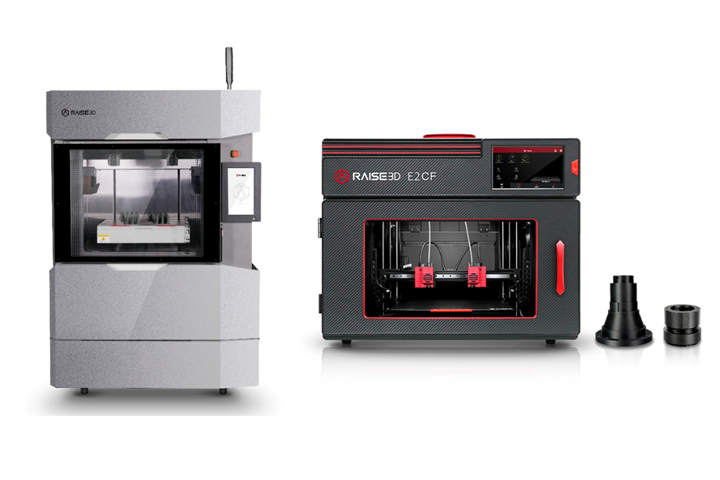Raise3D composite 3D printers feature open material platform
The RMF500 and E2CF 3D systems are equipped with enhancements to ensure precise and reliable handling of multiple chopped fiber filaments, polymers.
Raise3D (Rotterdam, Netherlands), a flexible additive manufacturing (AM) solutions provider, is presenting recent developments and innovations in fiber-reinforced composite 3D printing through its RMF500 and E2CF solutions first introduced in 2021, both of which use chopped fibers. In an effort to deliver precision and reliability through advanced materials, hardware and software optimization alongside innovation, both systems now feature an open material platform.
Thanks to the company’s Hyper fused filament fabrication (FFF) technology, Raise3D has introduced high-speed printing to the RMF500, an industrial-range 3D printer that is designed explicitly for carbon fiber-reinforced parts production. The team has developed a distinct solution in which most of the fibers flow within the nozzle’s core area, optimizing heat conduction, interlayer bonding and nozzle-abrasion behaviors.
“Fibers has not only unlocked enhanced performance but also presented
challenges in high-speed FFF 3D printing,” says Dr. Minde Jin (Ph.D.), director of materials and applications at Raise3D. “The key to overcoming these challenges lies in our deep understanding of fiber distribution and flow behavior, which we have successfully achieved. As we move forward, we will release an expanding range of Hyper Core filaments, featuring varying fiber content and polymer matrices, further pushing the boundaries of 3D printing.”
RMF500 is a large-volume (500 × 500 × 500 mm) printer. Its sturdy mechanical structure ensures precision and reliability. It achieves a maximum linear speed of 500 mm/s, an acceleration capability of 15,000 mm/s2 and volume speeds of 35mm3/s. It is equipped with independent dual extruders (IDEX), reportedly enabling it to double the productivity and versatility in multi-material printing. Moreover, a 4 × 2.5 kg filament system ensures continuous printing without interruptions. A built-in filament drying seal bags ensures optimal material conditions. The RMF500 also includes Raise3D’s 2-in-1 automatic filament switching designed to keep a user’s creative flow uninterrupted.
The E2CF is a professional-grade desktop 3D printer, also for carbon fiber-reinforced composite parts. It combines precision and reliability within a compact footprint, boasting a build volume of 330 × 240 × 240 mm. It also features IDEX and a double-gear extrusion system built with hardened components and silicon carbide nozzles, specifically optimized to handle the increased wear that occurs when printing with fiber-reinforced filaments. To ensure a stable printing process, the E2CF is equipped with two standalone sealed dry boxes developed by Raise3D. These dry boxes effectively combat the high water-absorption tendencies of nylon and fiber-reinforced filaments for consistent, high-quality prints.
Related Content
-
Plant tour: Albany Engineered Composites, Rochester, N.H., U.S.
Efficient, high-quality, well-controlled composites manufacturing at volume is the mantra for this 3D weaving specialist.
-
The next evolution in AFP
Automated fiber placement develops into more compact, flexible, modular and digitized systems with multi-material and process capabilities.
-
Combining multifunctional thermoplastic composites, additive manufacturing for next-gen airframe structures
The DOMMINIO project combines AFP with 3D printed gyroid cores, embedded SHM sensors and smart materials for induction-driven disassembly of parts at end of life.

















